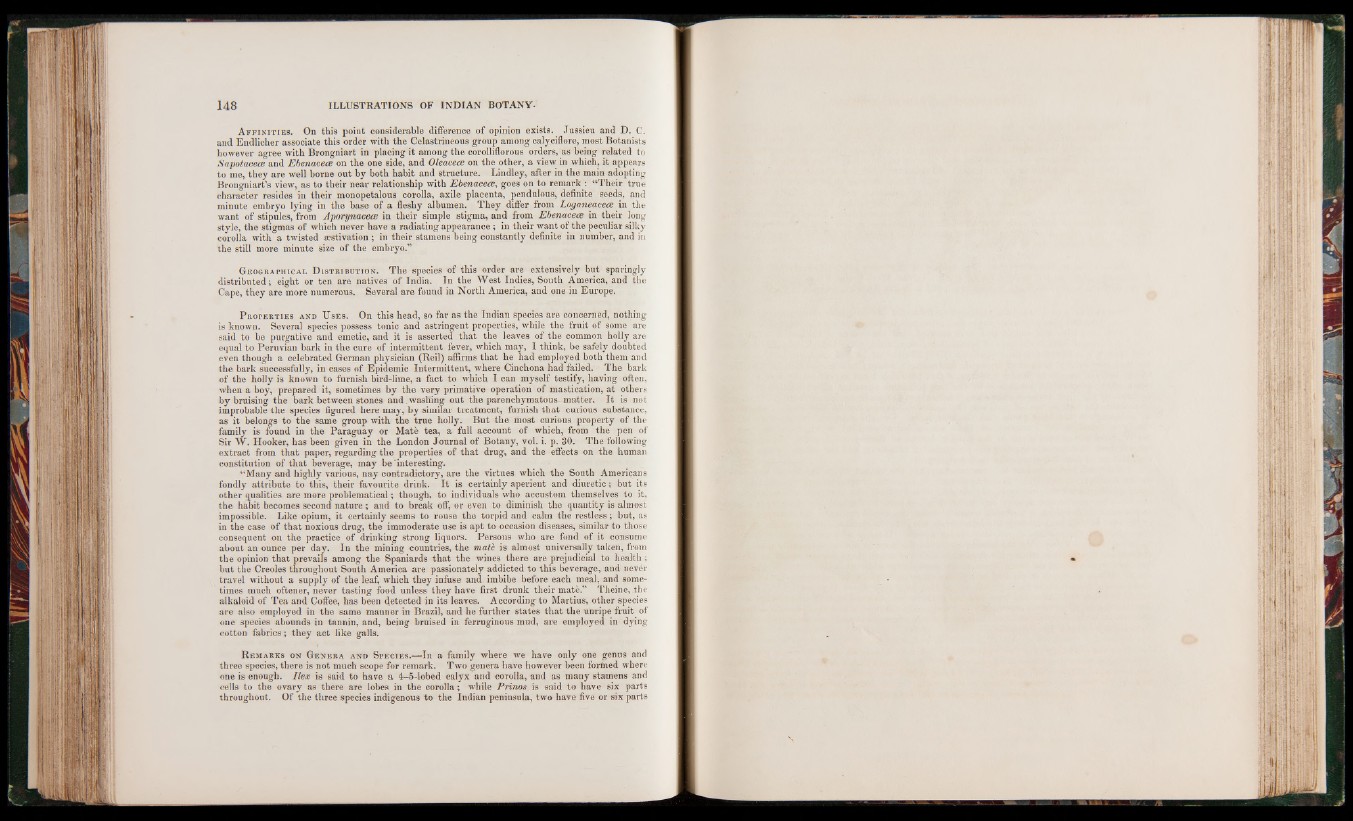
Aff in it ies . On this point considerable difference of opinion exists. Jussieu and D. C.
and Endlicher associate this order with the Celastrineous group among calyciflore, most Botanists
however agree with Brongniart in placing it among the corolliflorous orders, as being related to
Sapotacece and Ebenacece on the one side, and Oleacece on the other, a view in which, it appears
to me, they are well borne out by both habit and structure. Lindley, after in the main adopting
Brongniart’s view, as to their near relationship with Ebenacece, goes on to remark : “Their true
character resides in their monopetalous corolla, axile placenta, pendulous, definite seeds, and
minute embryo lying in the base of a fleshy albumen. They differ from Loganeacece in the
want of stipules, from Aporynacece in their simple stigma, and from Ebenacece in their long
style, the stigmas of which never have a radiating appearance ; in their want of the peculiar silky
corolla with a twisted aestivation; in their stamens being constantly definite in number, and in
the still more minute size of the embryo.”
Geographical D istribution. The species of this order are extensively but sparingly
distributed; eight or ten are natives of India. In the West Indies, South America, and the
Cape, they are more numerous. Several are found in North America, and one in Europe.
P roperties and U ses. On this head, so far as the Indian species are concerned, nothing
is known. Several species possess tonic and astringent properties, while the fruit o f some are
said to be purgative and emetic, and it is asserted that the leaves of the common holly are
equal to Peruvian bark in the cure of intermittent fever, which may, I think, be safely doubted
even though a celebrated German physician (Reil) affirms that he had employed both them and
the bark successfully, in cases of Epidemic Intermittent, where Cinchona had failed. The bark
of the holly is known to furnish bird-lime, a fact to which I can myself testify, having often,
when a boy, prepared it, sometimes by the very primative operation of mastication, at others
by bruising the bark between stones and . washing out the parenchymatous matter. I t is not
improbable the species figured here may, by similar treatment, furnish that curious substance,
as it belongs to the same group with the true holly. But the most curious property of the
family is found in the Paraguay or Mate tea, a full account of which, from the pen of
Sir W. Hooker, has been given in the London Journal of Botany, vol. i. p. 30. The following
extract from that paper, regarding the properties of that drug, and the effects on the human
constitution of that beverage, may be'interesting.
“Many and highly various, nay contradictory, are the virtues which the South Americans
fondly attribute to this, their favourite drink. It is certainly aperient and diuretic; but its
other qualities are more problematical; though, to individuals who accustom themselves to it,
the habit becomes second nature; and to break off, or even to diminish the quantity is almost
impossible. Like opium, it certainly seems to rouse the torpid and calm the restless; but, as
in the case of that noxious drug, the immoderate use is apt to occasion diseases, similar to those
consequent on the practice of drinking strong liquors. Persons who are fond of it consume
about an ounce per day. In the mining countries, the mate is almost universally taken, from
the opinion that prevails among the Spaniards that the wines there are prejudicial to health;
but the Creoles throughout South America are passionately addicted to this beverage, and nevér
travel without a supply of the leaf, which they infuse and. imbibe before each meal, and sometimes
much oftener, never tasting food unless they have first drunk their mate.” Theine, the
alkaloid of Tea and Coffee, has been detected in its leaves. According to Martius, other species
are also employed in the same manner in Brazil, and he further states that the unripe fruit of
one species abounds in tannin, and, being bruised in ferruginous mud, are employed in dying
cotton fabrics; they act like galls.
R emarks on Genera and Species.—In a family where we have only one genus and
three species, there is not much scope for remark. Two genera have however been forfried where
one is enough. Ilex is said to have a 4-5-lebed calyx and corolla, and as many stamens and
cells to the ovary as there are lobes in the corolla; while Prinos is said to have six parts
throughout. Of the three species indigenous to the Indian peninsula, two have five or six parts